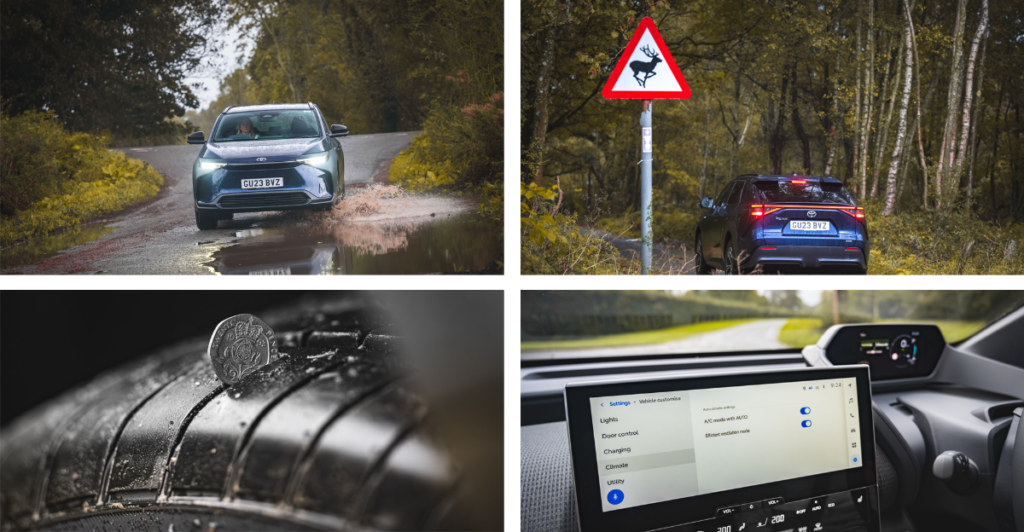Toyota autumn Driving Safety Tips

With the summer now over and the clocks changing this weekend, Toyota has put together some autumn driving safety tips to deal with challenging conditions such as wet roads, fog and shortened daylight hours that accompany the glorious autumn colours. According to research by the RAC Foundation*, road traffic collisions increase by 19 per cent in the fortnight after putting the clocks back one hour from British Summer Time (BST) to Greenwich Mean Time (GMT).
An all-wheel drive vehicle with strong on and off-road capabilities and a low centre of gravity for stability, such as the battery electric Toyota bZ4X AWD, will help drivers cope with difficult road conditions. However, the following tips apply to driving any car this autumn.
Slippery roads
Gold and copper leaves look beautiful on the trees but can become a hazard when they fall on wet roads, creating a skid risk and potentially obscuring road markings, or masking potholes. Take greater care when driving through areas bordered by deciduous trees by reducing speed, especially around corners.
Morning frost can create icy patches on shaded areas of the road and across bridges and overpasses. Take extra care by reducing your speed.
Rain and floods
Rain reduces your visibility and increases braking distances, so it’s advisable to double the distance between you and the car in front.
Use your headlights when visibility is reduced. Fortunately, many modern cars like the Toyota bZ4X have headlights that automatically switch on in low light conditions. You should regularly check the functioning of all your lights, and the condition of your windscreen wipers, replacing any defective bulbs and blades.
If the roads are flooded, bear in mind that a car can float in as little as two feet of standing water, so don’t attempt to cross deep water.
If crossing smaller pools of water, drive slowly but keep engine revs high if you’re driving a standard petrol or diesel vehicle to avoid stalling. Beware of bow waves from approaching vehicles that can create higher water levels.
Explaining aquaplaning
When rain is so heavy the road surface becomes awash, there’s a risk of aquaplaning, especially at high speeds. This is where the water between the road surface and the tyres leads to a loss of traction. If all four wheels are affected, there is a risk the car will ‘skate’ across the water, with complete loss of control. If the steering begins to feel light or unresponsive, ease off the accelerator and slow down gradually.
Dire tyres
October is Tyre Safety Month, so check that your tyres have sufficient tread depth to achieve good traction. The legal limit is 1.6mm but Toyota recommends a minimum of 3.0mm. A good test is to place a 20p coin in the main tread grooves of your tyre (within the central three-quarters of the tread width). If the outer band of the coin is visible, then your tread is below the legal limit and needs changing.
Wheels must be balanced, with equal tyre pressures left and right at each axle, so if your car seems to be slowly veering in one direction then either your tracking is out, your tyre pressures are unequal, or the treads on the front tyres don’t match and need attention.
Preparing for a cold spell
Prepare for a cold spell by ensuring fluids such as engine coolant and windscreen wash are at the correct dilution and topped-up. Visit Toyota’s official eBay store to replenish supplies.
Consider fitting cold-weather tyres, even if there’s snow isn’t forecast. They contain a higher percentage of natural rubber than a summer tyre so they remain supple and elastic when ambient temperatures are less than seven degrees Celsius. This allows the winter tyre to generate greater friction through its ability to flex and match the contours of the road. In addition, the deep tread pattern with small wavy incisions or stripes in each tread block act like thousands of tiny teeth biting into the road surface to provide additional grip, with less susceptibility to aquaplaning.
Be alert to animals and pedestrians
Longer hours of darkness mean you are less likely to spot dogs, cats or pedestrians crossing the road, so take extra care when driving in residential areas
Autumn coincides with deer breeding season, so be extra careful driving through rural and wooded areas, especially during sunrise and sunset when deer are most active. Take special note in areas where deer warning signs are displayed.
Beware of low visibility
Fog is one of the most dangerous weather conditions as an accident involving one vehicle can quickly involve others if cars are driving too close. Leave a distance of at least three seconds between you and the car in front.
Use your headlights and fog lights to increase your visibility to others. At junctions, wind down your window and listen for traffic.
Autumn mornings mean heavy dewfall. It’s important to clear all your car windows of moisture, inside (see below) and out, before driving off, so that your view isn’t compromised – just as you should de-ice them after night-time frosts. The job can be done in moments if you keep a cleaning blade in the car.
Beware of the fog on the inside of the car – vision clouded by condensation on the windows can be an issue during colder months when a build-up of moisture is caused by wet clothes, shoes or pets. Use the demister function to quickly clear the windscreen of condensation. Modern air conditioning systems in cars like the Toyota bZ4X offer different functions to help with keeping screens clear, so make sure you’re familiar with what your car’s climate control can do to help and remember to angle the air vents to achieve the best results.




